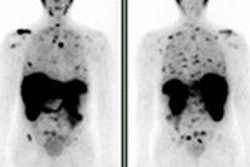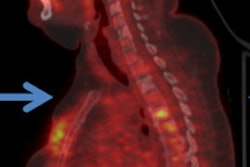
VANCOUVER - Exercise FDG-PET imaging significantly outperformed SPECT myocardial perfusion imaging (MPI) in detecting ischemia in patients with single-vessel disease, according to a study presented on Tuesday at the Society of Nuclear Medicine and Molecular Imaging (SNMMI) annual meeting.
In patients with stenosis greater than 50%, exercise FDG-PET achieved sensitivity of 96%, compared with 56% for stress technetium-99m (Tc-99m) tetrofosmin SPECT MPI. FDG-PET also showed 76% accuracy in this group, compared with 62% accuracy for stress MPI.
In patients with stenosis greater than 70%, both modalities performed equally well, the researchers concluded.
The findings could lead to the use of nuclear medicine in preventive cardiology, given FDG-PET's apparent ability to detect ischemia at a very early stage before changes become apparent with angiography, said lead researcher Dr. Arun Sasikumar, from the department of nuclear medicine at the Post Graduate Institute of Medical Education and Research (PGIMER) in Chandigarh, India.
The prospective study included 45 patients with clinical suspicion of coronary artery disease and no history of myocardial infarction. There were 37 men and eight women, with a mean age of 51 years (range, 27 to 71 years).
Imaging protocol
All patients underwent stress SPECT MPI using a treadmill on one day. Exercise FDG-PET (Discovery STE, GE Healthcare) was performed after injecting 5 mCi of FDG on another day.
The researchers suppressed physiologic myocardial FDG uptake in patients by having them eat a high-fat, high-protein, low-carbohydrate meal prior to FDG-PET. All 45 patients also underwent coronary angiography within 30 days of the other scans to provide a baseline for comparison between SPECT MPI and FDG-PET results.
Twenty-seven patients had abnormal coronary angiography results that showed at least one coronary artery with stenosis greater than 50%. Of those individuals, 17 had single-vessel disease, five had double-vessel disease, and five had triple-vessel disease.
Among the 17 patients with single-vessel disease, FDG-PET significantly outperformed SPECT MPI (p = 0.0005). In patients with greater than 50% stenosis, exercise FDG-PET had sensitivity of 96%, compared with 56% for stress SPECT MPI. Accuracy was 76% for FDG-PET, compared with 62% for SPECT MPI, proving that FDG-PET catches earlier stages of disease, according to the researchers.
In the patients with multivessel disease, exercise FDG-PET performed as well as stress SPECT MPI (for double-vessel disease, p = 0.683; for triple-vessel disease, p = 1.0).
| FDG-PET vs. SPECT MPI for ischemia | ||
| Exercise FDG-PET | Stress SPECT MPI | |
| Sensitivity | 96% | 56% |
| Specificity | 44% | 72% |
| Positive predictive value | 72% | 75% |
| Negative predictive value | 89% | 52% |
| Accuracy | 76% | 62% |
Exercise FDG-PET also was statistically better than stress SPECT MPI in the left anterior descending and left circumflex arteries with comparably good performance in the right coronary artery. In patients with stenosis greater than 70%, both modalities performed equally well (p = 0.61).
Given exercise FDG-PET's prowess, physicians could prescribe medications that can halt disease progression and prevent a potentially devastating cardiac event, such as a heart attack or sudden cardiac death, Sasikumar and colleagues concluded.
Exercise FDG-PET could also be useful for initial coronary artery disease screening to help doctors better determine a patient's cardiac risk and manage care.



















